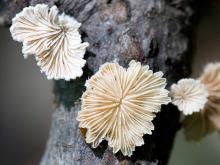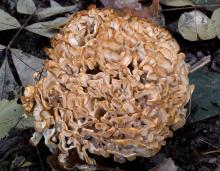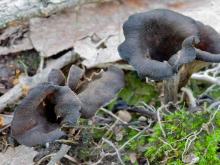Mushrooms
Media

Species Types
Scientific Name
Schizophyllum commune
Description
Split gills grow in clusters with small, white, hairy, fan-shaped caps. Beneath, they have whitish or pinkish gill-like folds that split toward the edge. They grow on dead branches of deciduous trees.
Media

Species Types
Scientific Name
Grifola frondosa
Description
Looking like a ruffled chicken, the edible hen of the woods mushroom grows like large circular bouquet of spoon-shaped caps, each grayish brown on top and white beneath, emerging from a branching, whitish base. It grows on the ground at the base of oak trees.
Media

Species Types
Scientific Name
Meripilus sumstinei (formerly M. giganteus)
Description
The black-staining polypore grows in large, circular clusters of many fleshy, grayish yellow, fan-shaped caps, which bruise black when cut or touched. It grows on the ground around deciduous trees, especially oaks.
Media

Species Types
Scientific Name
Sparassis spathulata (S. herbstii)
Description
The eastern cauliflower mushroom is a large, stalkless, whitish yellow rosette with flattened, wavy, ribbonlike folds. It grows singly, at the bases of trees and often at the base of decayed oak stumps.
Media

Species Types
Scientific Name
Cantharellus lateritius
Description
The smooth chanterelle has a bright orange to yellow cap, wavy margins, and is smooth on the underside. It grows singly or in large groups in the soil.
Media

Species Types
Scientific Name
Craterellus cornucopioides (C. fallax)
Description
The black trumpet is dark brown to black, vase- or trumpet-shaped, with a wavy margin and no gills. It grows in groups of few to many on rocky, mossy hillsides in deciduous woods.
Media

Species Types
Scientific Name
Hericium erinaceus
Description
The bearded tooth is a beardlike, whitish mass that grows on trunks of living deciduous trees and on fallen trees and logs.
Media

Species Types
Scientific Name
Hydnum repandum (Dentinum repandum)
Description
The hedgehog mushroom has an irregularly shaped, dull orangish tan cap, with spines or "teeth" on its underside. It grows on the ground in mixed woods.
Media

Species Types
Scientific Name
Tremellodendron pallidum
Description
The jellied false coral is a branching, whitish, leathery, coral-like jelly fungus. It grows on the ground in deciduous or mixed woods.
Media

Species Types
Scientific Name
Artomyces pyxidatus (formerly Clavicorona pyxidata)
Description
The crown-tipped coral is a many-branched, coral-like mushroom that is yellowish tan with crownlike tips. It grows on the dead wood of deciduous trees.
See Also



Media

Species Types
Scientific Name
Monotropa hypopitys
Description
Pinesap is a plant that puts the "wild" in wildflower! It lacks chlorophyll, so its roots connect to fungi underground and absorb nutrients from the fungi.
Media

Species Types
Scientific Name
Cladophora, Pithophora, and Spirogyra spp., and others
Description
Filamentous green algae forms green, cottony masses that are free-floating or attached to rocks, debris, or other plants.
Media

Species Types
Scientific Name
Monotropa uniflora
Description
Indian pipe lacks chlorophyll, so it is white, not green. Below ground, its roots join with fungi that connect to tree roots. This plant, then, takes nourishment indirectly from the trees.
About Mushrooms in Missouri
Mushrooms are a lot like plants, but they lack chlorophyll and have to take nutrients from other materials. Mushrooms are neither plants nor animals. They are in a different kingdom — the fungi. Fungi include the familiar mushroom-forming species, plus the yeasts, molds, smuts, and rusts.
Always be cautious when eating edible mushrooms. Be absolutely sure of the ID, and only eat a small amount the first time you try it to avoid a reaction..





















